Look around you: smart phones are everywhere. As a working professional, you probably have a smartphone in your pocket right now. Sure, there are plenty of reasons why you have a smartphone: these devices have so many features and applications they could make your head spin. Overall, having a cell phone is just plain ‘old convenient, and most American consumers agree. 83% of American adults own a smartphone now, and 73% of those owners use text messaging.
If so many consumers are using text messaging daily, the real question is: why aren’t you using text to communicate with them?
According to the Pew Research Center, 31% of Americans prefer text messages to phone calls, and an additional 14% said the method they prefer depends upon the situation. A recent Gallup poll stated “sending and receiving text messages is the most prevalent form of communication for American adults under 50.” The statistics show: texting is not just a fad, but rather a viable, popular method of communication for the average American.
All this technology isn’t only changing the way businesses operate; it’s also changing the way your customers think.
Because the consumer experience has become such an important focus of businesses nowadays, consumers are beginning to not only want a superior experience, but expect it. The consequences if you don’t are now greater than ever, too: research shows 95% of bad experiences are shared online, and 39% of consumers tend to avoid vendors for two or more years after a bad experience.
To keep up with the changing times, your business needs to start offering texting as an option for customer communications.
Still not convinced? Here are five key benefits of text messaging over standard phone calls.
No One Listening In
How many times have you been in public, and wished someone would just text instead of call (especially if they’re on speakerphone)? Texting means privacy from the people around you, not only to protect your own information, but also to be less disruptive to those around you. This also means that it’s easier and more convenient to answer text messages in daily situations where you could not answer a call, such as in a meeting, at the hair salon, in line at the supermarket, etc.
Greater Accessibility
There’s nothing more frustrating than saying “can you hear me now?” over and over again. It’s not just poor cell service that phone calls
are susceptible to; it’s ambient noise, loud environments, poor network connections, or even malfunctioning Bluetooth devices that can make a simple phone call an uphill battle. Text messages eliminate all of that nonsense, and also are more accessible to people with hearing impairments.
Time
Probably one of the biggest reasons consumers prefer texting over calls is that there is far less pressure. No pressure to think of responses right away, no pressure to make small talk while the person on the other end fulfills a task. Through text messaging, there is

a text message, and customers won’t be prone to impatience or negative experiences associated with waiting on hold, either.
not only more time to think of appropriate, exact responses to questions or statements, but there is also less social “fluff” surrounding those responses. Texts are meant to be short and to the point, meaning more efficient exchange of information. It also takes the pressure off employees during busy days as well; you won’t have someone waiting on hold with
Competitors
More and more businesses are understanding the necessity of great consumer experience, and many times, how well you take care of your customers and the options you offer them can be the difference between you and a competitor. Consumer experience isn’t just about having a great product or great employees; it’s about making your customers feel special, taken care of, and like they’re consistently included in what you’re doing.
Take, for example, your service drive. Customers drop off their cars and most likely, their entire lives are put on hold; they’re thinking about getting to work, picking up their kids, and a million other things they need their cars for. Offering these customers the ability to text employees to receive updates, ask questions, clarify pricing, and even just to say thank you, can elevate your experience higher than you ever imagined—and higher than your competition.
People Will Answer
Text messages have a 98% open rate. Compare this to emails, which have a 20% open rate. The difference is pretty steep, right? If you need to communicate immediately with your customers, a text message is almost sure to get to them and be read every time. This means that your employees will spend less time playing phone tag and leaving messages, and more time doing more important tasks. Not only will your customers remain informed and happy, but your employees can deliver a seamless customer experience with minimal effort and minimal time chained to the phone.
All of these reasons are great, but how can you get your service advisors, sales people, or any employee to text? Well, other than its efficiency, text messaging sets your employees and your business up for success. Research indicates that $62 billion is lost by US businesses each year because of bad customer experiences—don’t let your business fall into that category.
Status Updates Can Improve Customer Satisfaction Rating By 10%
Automated status updates ensure customers are kept informed during the service lifecycle.
Reduce inbound and outbound calling between service writers and customers with real-time status updates via text messaging and email.
Available analytics in real-time provide realistic target date and time on all delivery promises. Customers are able to schedule and plan their day more efficiently.
Texting is 10 times quicker than phone calls – by the time you make one call to a single customer, texting would have enable an effortless communication with 10 customers.
The essential truth about retaining customers is the way you are able to keep them engaged. As the old saying goes – the best way to grow your customers is not to lose them.

 Harmony AI
Harmony AI Intelligent Appointments
Intelligent Appointments Tablet Vehicle Check-In
Tablet Vehicle Check-In Digital MPI
Digital MPI UpdatePromise App
UpdatePromise App AI-Driven Status Updates
AI-Driven Status Updates Dashboard Analytics
Dashboard Analytics AutoRepair-Review.com
AutoRepair-Review.com Full Merchant Services
Full Merchant Services Clover & Payment Devices
Clover & Payment Devices SmartPath Service
SmartPath Service MONOGRAM Service
MONOGRAM Service Honda
Honda Acura
Acura Audi
Audi Hyundai + Genesis
Hyundai + Genesis Sunbit
Sunbit All Features
All Features

